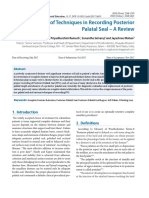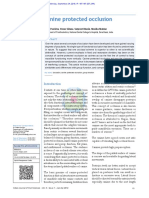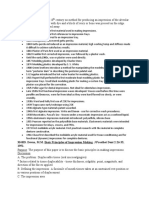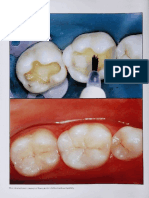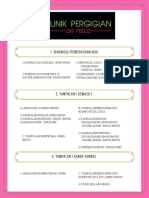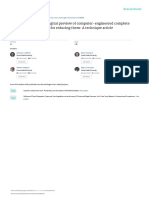Occlusion in Implant Prosthodontics: Radhika B Parekh, Omkar Shetty, Rubina Tabassum
Occlusion in Implant Prosthodontics: Radhika B Parekh, Omkar Shetty, Rubina Tabassum
Uploaded by
Tung Thanh NguyenCopyright:
Available Formats
Occlusion in Implant Prosthodontics: Radhika B Parekh, Omkar Shetty, Rubina Tabassum
Occlusion in Implant Prosthodontics: Radhika B Parekh, Omkar Shetty, Rubina Tabassum
Uploaded by
Tung Thanh NguyenOriginal Title
Copyright
Available Formats
Share this document
Did you find this document useful?
Is this content inappropriate?
Copyright:
Available Formats
Occlusion in Implant Prosthodontics: Radhika B Parekh, Omkar Shetty, Rubina Tabassum
Occlusion in Implant Prosthodontics: Radhika B Parekh, Omkar Shetty, Rubina Tabassum
Uploaded by
Tung Thanh NguyenCopyright:
Available Formats
[Downloaded free from http://www.jdionline.org on Thursday, May 20, 2021, IP: 118.70.129.
136]
REVIEW ARTICLE
Occlusion in implant prosthodontics
Radhika B Parekh, Omkar Shetty, Rubina Tabassum
ABSTRACT
Implant prosthodontics is a vast and varied field. The most crucial stage in the replacement of
a missing tooth using an implant supported prosthesis is the occlusal loading of the fixture. The
longevity and the success of the restoration are primarily determined by the direction and amount
forces in occlusion. The quality of bone, type of implant, type of prosthesis and patient factors all
play important roles in the selection of an occlusal scheme. Each patient must be treated with an
individualistic approach. The guidelines for the choice of restoration or type of occlusal scheme must
be customized to allow for longevity of the restoration in harmony with the health of the surrounding
dentoalveolar structures. This review article encapsulates the different factors to be considered while
planning implant restorations and establishing occlusal and prosthetic schemes to protect and preserve
the associated oral structures.
KEY WORDS: Implant prosthodontics, implants, occlusion
INTRODUCTION The outcome of treatment is often quite successful in
spite of the fact that dentists use different concepts of
The ultimate success and longevity of any restoration in occlusion. Individuals with an ideal occlusion are seldom
the oral cavity is dependent on the forces which act on and most of our patients deviate in one or more ways
it and the ability of the underlying structures to absorb from the ideal norm of occlusion but may still function
or react to these forces. Occlusion is critical for implant well. They are physiologically acceptable and do not
longevity because of the nature of the attachment of the need any intervention.[1‑3]
bone to the titanium surfaced implant. Occlusal overload
and its relationship to implant overload and failure is a A therapeutic occlusion has been defined as one modified
well‑accepted phenomenon. by various therapeutic measures so that it falls within
the parameters of a physiological occlusion. Among
Most occlusal concepts and ideas have been designed the many varying recommendations for therapeutic
for natural teeth and are applied to implants without occlusions presented in prosthodontic textbooks, a
any modification and as osseointegrated implants lack concept of a functionally optimal occlusion originally
specific defence mechanisms, poorly restored occlusion presented in the 1950s by Beyron[4,5] has gained much
on osseointegrated implants can result in deleterious support over the years and has been considered to
effects to the prosthesis and supporting alveolar bone. have stood the test of time.[6] Some of the occlusal goals
for implant supported restorations[7] are (i) bilateral
Department of Prosthodontics, Dr. Dnyandeo Yashwantrao Patil simultaneous contacts and equal distribution of occlusal
Dental College and Hospital, Nerul, Navi Mumbai, India forces[8] (ii) no occlusal prematurities[9] (iii) Smooth,
Address for correspondence: Dr. Radhika B Parekh, even lateral excursive movements with no non‑working
20 Kailas, 50 Pedder Road, Mumbai ‑ 400 026, India. interferences[10] (iv) No soft tissue impingement during
E‑mail: dr.radhikabparekh@gmail.com
occlusal contact.
Access this article online
Quick Response Code: As compared to endosteal implants, natural teeth are
Website: designed to reduce the force that it receives by various
www.jdionline.org
mechanisms, the periodontal membrane which acts
a visco‑elastic shock absorber, biomechanical design,
DOI: elastic modulus of supporting tissues, occlusal material
10.4103/0974-6781.118856 and type of surrounding bone all aid in decreasing the
occlusal forces that the tooth can sustain.
Journal of Dental Implants | Jul - Dec 2013 | Vol 3 | Issue 2 153
[Downloaded free from http://www.jdionline.org on Thursday, May 20, 2021, IP: 118.70.129.136]
Parekh, et al.: Implant occlusion
Conversely the rigid fixation between the implant and RELATION OF SURFACE AREA TO STRESS
the surrounding bone does not allow for dissipation of DISTRIBUTION
the occlusal forces that it receives, thus often translating
into problems with the prosthesis, the screws that The forces that are delivered to the implant must be
holding the implants and abutments or the frameworks able to be capably sustained with minimum effect on
together often fracture, and in cases of cement retained the surrounding crestal bone. Studies have shown that
restoration shear stresses at the cement interface cause when implants of decreased surface area are subjected
de‑cementation. The precursor signs of premature to angled loads, the magnified stress and strain
contact or occlusal overload on natural teeth are usually magnitudes in the interfacial tissues can be minimized
hyperemia, sensitivity or in severe cases, mobility by placing an additional implant in the region of
whereas implants rarely show any clinical signs other concern.[16‑19] In cases where forces are increased in
than fatigue fracture. magnitude, direction, or duration (parafunction)
ridge augmentation, reduction in crown height or
PREMATURE OCCLUSAL CONTACTS increase in implant width or number may be useful in
compensating for the increased stresses. The type of
Initial tooth movement ranges from 8 µ to 28 µ in a prosthesis may also be modified from a fixed prosthesis
vertical direction under a 3 lb‑5 lb load depending on to a removable prosthesis while incorporation of
factors such as tooth shape, position, geometry of roots, modifications such as increased soft tissue support to
and time elapsed since last load application.[11,12] The relieve undue stresses.
secondary tooth movement is similar to the movement
seen in implants (3 µ‑5 µ)[12] and is reflective of the OCCLUSAL SCHEME FOR IMPLANT
property of the surrounding bone. When teeth come RESTORATIONS
in contact, the combined intrusive movement is about
56 µ (28 µ +28 µ) but when an implant opposes a natural The most ideal occlusal concept advocated for implant
tooth, only 28 µ of movement occurs, hence though the supported restorations is that of mutually protected
occlusal design may be ideal, premature occlusal contacts articulation. The posterior and anterior groups of teeth
on the implant may still occur due to the difference in mutually protect each other. In protrusion, only the
the vertical movement of the teeth and the implants anterior teeth are controlled by the incisal guidance[20] and
in the same arch. The implant prosthesis should just there is uniform disocclusion seen in the posterior region
barely contact and the surrounding teeth in the arch whereas in centric occlusion there is intercuspation of
should exhibit greater initial contacts. Hence, in cases the posterior teeth and the anterior teeth are free of any
of implants restorations opposed by natural teeth, the contact. In cases where a healthy canine is present, only
dentist should use a heavy bite force followed by a light the canine disoccludes the rest of the posterior teeth in
bite force to differentiate between the occlusal contacts. lateral excursions.[21‑23]
Heavy bite forces causes depression of the natural
teeth and positions them closer to the implant and thus In implant prosthodontics, the incisal guidance should
permits equal sharing of the load.[13] In situations where be as shallow as possible, Weinberg and Kruger[24]
implant restorations oppose each other in two posterior noted that for every 10‑degree change in the angle
quadrants the heavy bite force must account for the of disocclusion, there was a 30% difference in the
56‑µ difference in vertical movement of the teeth in the load. Hence all lateral excursions opposing fixed
contra‑lateral quadrants. Anteriorly teeth exhibit greater prostheses or natural teeth must disocclude all posterior
apical and lateral movement then the implants hence in components.
clinical situations of anterior implants, first a light biting
force with a thin articulating paper is used (20 µm) to DIRECTION OF OCCLUSAL LOADING
ensure that no implant crown comes in contact during
the initial movement, followed by a heavy biting force in The primary component of the occlusal force should
centric occlusion so as to develop simultaneous contacts be directed along the long axis of the implant, not
on the implants and crowns. Isidor et al.,[14,15] reported at an angle. Angled abutments should only be used
that excessive occlusal overloading can cause severe to improve esthetics or allow for a favorable path of
crestal bone resorption and loss of osseointegration. withdrawal.
An important aspect of occlusal adjustment for implant CANTILEVERS
restorations is the periodic recall and re‑evaluation of the
occlusal contacts. This ensures the longevity and success When cantilevers are used, the maximum length of the
of the restoration. cantilever should never exceed 20 mm and it is best kept
154 Journal of Dental Implants | Jul - Dec 2013 | Vol 3 | Issue 2
[Downloaded free from http://www.jdionline.org on Thursday, May 20, 2021, IP: 118.70.129.136]
Parekh, et al.: Implant occlusion
less than 15 mm.[25] The shorter the length minimizes PROGRESSIVE BONE LOADING
the torque to the posterior implant abutment thereby
reducing crestal bone loss on the distal implant. Duyck The concept of progressive loading considers the role of
et al.,[26] reported that when a biting force was applied to Wolffs law[29] where bone mass increases in response to
a distal cantilever, the highest axial forces and bending controlled stresses. Gradually increasing the load applied
movements recorded on the distal implants were more to implants in poor quality bone to increase the mass
pronounced in prostheses with only three implants and density by gradually increasing the function. The
compared those with five or six implants. Eliminating elements of progressive loading include the time interval,
prematurities in RCP and IP, reduction in the occlusal diet, occlusal material, occlusal contacts, and prosthesis
table and reducing the occlusal contacts also aid in the design.[13] The time interval between the two surgical
reduction in the occlusal contacts, no lateral loads are appointments depends on the type of bone (D1‑D4)
applied to the cantilever portion of the restoration.[27] in which the implant is placed. The diet of the patient
is controlled from soft to semi‑soft to hard in order to
CROWN MODIFICATIONS be able to control the amount of force being delivered
to the implant. The occlusal material is initially acrylic
The greater the crown height, the greater the resulting or composite resin which is later replaced by metal
crestal moment with any lateral component of force or ceramometal. The prosthesis is initially kept out of
including those forces that develop because of an function and slowly occlusal contacts are increased
angled load.[28] The central fossa of an implant crown though cantilevers are always kept of occlusion.
should be 2-3‑mm wide in the posterior teeth and
parallel to the occlusal plane. Secondary contacts CONCLUSIONS
should remain within 1 mm of the periphery of the
implant to decrease the moment loads and marginal The success of an implant is based on its long‑term
ridge contacts should be avoided. Splinted crowns also prosthetic efficiency, careful treatment planning and
decrease occlusal forces to the crestal bone and reduce sound decision play a vital role in its success. Careful
abutment screw loosening; hence adjacent implant consideration should be made in identifying the weakest
crowns should be splinted. The center of the implant link in the overall restoration and establishing occlusal
most often is placed in the center of the edentulous and prosthetic schemes to protect that component of
ridge, as the ridge shifts lingually with resorption, the the structure. Each patient must be treated with an
implant body is most often not under the buccal cusp individualistic approach. The guidelines for the choice
tips but rather near the central fossa or sometimes of restoration or type of occlusal scheme [Table 1] must
under the lingual cusp of the natural tooth. A buccal be customized to allow for longevity of the restoration
or lingual cantilever is called an offset load, which in harmony with the health of the surrounding
acts as a class 1 lever. Greater the offset, greater the dentoalveolar structures.
compressive tensile and shear forces at the implant
crest. Hence, reduction in buccolingual dimension of REFERENCES
the crown helps minimize these loads.[13]
1. Türp JC, Greene CS, Strub JR. Dental occlusion: A critical
Table 1: Occlusal schemes for various reflection on past, present and future concepts. J Oral Rehabil
prosthetic options 2008;35:446‑53.
2. Carlsson GE, Haraldson T, Mohl ND. The dentition. In:
Single tooth implants/ Maintain the occlusal
Mohl ND, Zarb GA, Carlsson GE, Rugh JD, editors. A Textbook
Tooth‑bound implant scheme of the patient with of Occlusion. Chicago: Quintessence; 1988. p. 57‑69.
restorations the restoration in minimal 3. Mohl ND. Diagnostic rationale: An overview. In: Mohl ND,
occlusal contact Zarb GA, Carlsson GE, Rugh JD, editors. A Textbook of
One arch (Maxillary/Mandibular) Mutually protected occlusion Occlusion. Chicago: Quintessence; 1988. p. 179‑84.
implant supported fixed with a Unilateral balance 4. Beyron HL. Characteristics of functionally optimal occlusion
prosthesis opposed by natural (Group function occlusion) and principles of occlusal rehabilitation. J Am Dent Assoc
dentition 1954;48:648‑56.
Implant supported overdenture Mutually protected occlusion 5. Beyron H. Occlusion: Point of significance in planning
opposed by natural dentition with a Unilateral balance restorative procedures. J Prosthet Dent 1973;30:641‑52.
(Group function occlusion) 6. Zarb GA, Fenton AH. Prosthodontic, operative, and orthodontic
Implant supported overdenture Bilateral balanced occlusion therapy. In: Mohl ND, Zarb GA, Carlsson GE, Rugh JD, editors.
A Textbook of Occlusion. Chicago: Quintessence; 1988.
opposed by complete denture
p. 305‑28.
Implant supported overdenture Mutually protected occlusion
7. Tangerud T, Carlsson GE. Jaw registration and occlusal
opposed by implant supported with a Unilateral balance morphology. A textbook of fixed prosthodontics. The
overdenture (Group function occlusion) Scandinavian Approach. Stockholm: Gothic 200 p. 209‑30.
Journal of Dental Implants | Jul - Dec 2013 | Vol 3 | Issue 2 155
[Downloaded free from http://www.jdionline.org on Thursday, May 20, 2021, IP: 118.70.129.136]
Parekh, et al.: Implant occlusion
8. Beyron H. Optimal Occlusion. Dent Clin North Am effect of short implant usage in place of cantileve extensions in
1969;13:537‑54. mandibular posterior edentulism. J Oral Rehabil 2002;29:350‑6.
9. Ramfjord SP, Ash MM. Occlusion. 3 rd ed. Philadelphia: 20. Williamson EH, Lundquist DO. Anterior Guidance: Its effect
W.B. Saunders Co.; 1971. on electromyographic activity of the temporal and masseter
10. Dawson PE. Evaluation, diagnosis and treatment of occlusal muscles. J Prosthet Dent 1983;49:816‑23.
problems: A textbook of occlusion. St Louis: CV Mosby Co.; 21. D’Amico. The canine teeth: Normal function relation of the
1989. natural teeth of man. J South Calif Dent Assoc 1958;26:1‑7.
11. Muhlemann HR, Savdir S, Rakeitshak KH. Tooth mobility: Its 22. Goldstein GR. The relationship of canine‑protected occlusion
cause and significance. J Periodontol 1965;36:148‑53. to a periodontal index. J Prosthet Dent 1979;41:277‑83.
12. Sekine H, Komiyama Y. Mobility characteristics and tactile 23. Alexander PC. Analysis of cuspid protected occlusion. J Prosthet
sensitivity of osseointegrated fixture supporting systems. Tissue Dent 1963;13:307‑17.
integration in oral maxillofacial reconstruction. Amsterdam: 24. Weinber LA, Kruger G. A comparison of implant/prosthesis
Elsevier; 1986: 306‑32. loading with four clinical variables. Int J Prosthodont
13. Misch CE. Occlusal considerations for implant supported 1995;8:421‑33.
prostheses. Contemporary Implant Dentistry. St Louis: Mosby; 25. Kirsch A, Mentag PJ. The IMZ endosseous two phase implant
1993. system: A complete oral rehabilitation treatment concept. J Oral
14. Isidor F. Loss of osseointegration caused by occlusal load of oral Implantol 1986;12:576‑89.
implants. A clinical and radiographic study in monkeys. Clin 26. Duyck J, Van Oosterwyck H, Vander Sloten J, De Cooman M,
Oral Implants Res 1996;7:143‑52. Puers R, Naert I. Magnitude and distribution of occlusal forces
15. Isidor F. Histological evaluation of peri‑implant bone of implants on oral implants supporting fixed prosthesis: An in vivo study.
subjected to occlusal overload or plaque accumulation. Clin Clin Oral Implants Res 2000;11:465‑75.
Oral Implants Res 1997;8:1‑9. 27. Shackelton JL, Carr L, Slabbert JC, Becker PJ. Survival of fixed
16. Rangert B, Krogh PH, Langer B, Van Roekel N. Bending overload implant‑supported prostheses related to cantilever lengths.
and implant fracture: A retrospective clinical analysis. Int J Oral J Prosthet Dent 1994;71:23‑6.
Maxillofac Implants 1995;10:326‑34. 28. Bidez MW, Misch CE. Force transfer in implant dentistry: Basic
17. Gunne J, Jemt T, Linden B. Implant treatment in partially concepts and principles. J Oral Implantol 1992;18:264‑74.
edentulous patients: A report on prostheses after 3 years. Int J 29. Wolff: Dorlands Illustrated Medical Dictionary. 29 th ed,
Prosthodont 1994;7:143‑8. Philadelphia: W.B.Saunders.
18. Lekholm U, van Steenberghe D, Hermann I. Osseointegrated
implants in the treatment of partially edentulous jaws:
How to cite this article: Parekh RB, Shetty O, Tabassum R. Occlusion in
A prospective 5 year multicenter study. Int J Oral Maxillofac implant prosthodontics. J Dent Implant 2013;3:153-6.
Implants 1994;9:627‑35.
Source of Support: Nil, Conflict of Interest: None.
19. Akca K, Iplikcioglu H. Finite element stress analysis of the
156 Journal of Dental Implants | Jul - Dec 2013 | Vol 3 | Issue 2
You might also like
- Principle of Design For RPDDocument24 pagesPrinciple of Design For RPDArati P HoskhandeNo ratings yet
- Ortd 323-Answer Key: Final Examination Thursday, June 13, 2002Document10 pagesOrtd 323-Answer Key: Final Examination Thursday, June 13, 2002Ali AlyaNo ratings yet
- Occlusion For Implant Suppported CDDocument4 pagesOcclusion For Implant Suppported CDpopat78No ratings yet
- Evolution of Techniques in Recording Posterior Palatal Seal - A ReviewDocument5 pagesEvolution of Techniques in Recording Posterior Palatal Seal - A ReviewKrupali JainNo ratings yet
- Canine Protected OccDocument6 pagesCanine Protected OccDariana JDNo ratings yet
- Twin-Tables Technique For Occlusal Rehabilitation: Part II - Clinical ProceduresDocument7 pagesTwin-Tables Technique For Occlusal Rehabilitation: Part II - Clinical ProceduresSkAliHassanNo ratings yet
- Posterior Palatal SealDocument7 pagesPosterior Palatal SealÄpriolia SuNo ratings yet
- Impression Technique PDFDocument4 pagesImpression Technique PDFPremshith Cp100% (1)
- Osseointegration Short Review PDFDocument5 pagesOsseointegration Short Review PDFkryptonites1234No ratings yet
- Silverman 1971Document19 pagesSilverman 1971Krupali JainNo ratings yet
- Articulators Through The Years Revisited From 1971Document9 pagesArticulators Through The Years Revisited From 1971Nicco MarantsonNo ratings yet
- Group Function Occlusion I JosDocument6 pagesGroup Function Occlusion I JosAnonymous gVCIYF6dFNo ratings yet
- Balanced Occlu HandoutDocument9 pagesBalanced Occlu HandoutMostafa FayadNo ratings yet
- Lingualized Occlusion ReviewDocument3 pagesLingualized Occlusion ReviewJessy ChenNo ratings yet
- Basic Principles in Impression Making M M DevanDocument6 pagesBasic Principles in Impression Making M M Devanmfaheemuddin85100% (1)
- Conceptions and Misconceptions About Centric Relation: A Review of LiteratureDocument5 pagesConceptions and Misconceptions About Centric Relation: A Review of LiteratureSahana RangarajanNo ratings yet
- StentsDocument11 pagesStentsIbrahim Ramadan Eltorky33% (3)
- 30-003. Devan, M.M. Basic Principles of Impression Making. J Prosthet Dent 2:26-35, 1952Document9 pages30-003. Devan, M.M. Basic Principles of Impression Making. J Prosthet Dent 2:26-35, 1952Prashanth MarkaNo ratings yet
- Diagnosis and Treatment Planning in FPDDocument109 pagesDiagnosis and Treatment Planning in FPDvergel john ErciaNo ratings yet
- Management of Acquired Maxillary Defects Partially Edentlous PDFDocument129 pagesManagement of Acquired Maxillary Defects Partially Edentlous PDFRamy Khalifa Ashmawy100% (1)
- Occlusion in FPD 13-08-10Document104 pagesOcclusion in FPD 13-08-10Leavatte100% (1)
- Horizontal Jaw RelationDocument28 pagesHorizontal Jaw RelationVidya SenthuNo ratings yet
- Full Mouth Rehabilitation in A Case of Severely at PDFDocument6 pagesFull Mouth Rehabilitation in A Case of Severely at PDFMayank MalraNo ratings yet
- Lingualised Occ RevisitedDocument5 pagesLingualised Occ RevisitedDrPrachi AgrawalNo ratings yet
- Rudloph Hanau ArticulatorsDocument10 pagesRudloph Hanau ArticulatorsRik ChatterjeeNo ratings yet
- Aull. A Study of The Transverse Axis. (1963)Document11 pagesAull. A Study of The Transverse Axis. (1963)Jose Enrique AvilaNo ratings yet
- An Insight Into Gothic Arch Tracing: July 2019Document7 pagesAn Insight Into Gothic Arch Tracing: July 2019Praveen KumarNo ratings yet
- Border Molding in Complete DentureDocument40 pagesBorder Molding in Complete DentureVishnu S Pattath0% (1)
- Streamline Introduction of PonticsDocument0 pagesStreamline Introduction of PonticsAmar BhochhibhoyaNo ratings yet
- Impression Making in CDDocument8 pagesImpression Making in CDAMAN RAJPUTNo ratings yet
- Implant Loading Protocols For The Partially Edentulous Esthetic ZoneDocument11 pagesImplant Loading Protocols For The Partially Edentulous Esthetic ZoneKarla AlanisNo ratings yet
- Arrangement of Posterior Artificial TeethDocument5 pagesArrangement of Posterior Artificial TeethShreyans DamadeNo ratings yet
- Masticatory EfficiencyDocument19 pagesMasticatory EfficiencyVikas AggarwalNo ratings yet
- Concept of Shortened Dental Arch An OverviewDocument3 pagesConcept of Shortened Dental Arch An OverviewHarold CamargoNo ratings yet
- Management of Flabby RidgeDocument4 pagesManagement of Flabby RidgesalmaNo ratings yet
- JInterdiscipDentistry3112-5456729 150927Document6 pagesJInterdiscipDentistry3112-5456729 150927Nisha GargNo ratings yet
- Centric Jaw RelationDocument7 pagesCentric Jaw RelationMamta SentaNo ratings yet
- CPD DesignDocument8 pagesCPD DesignMayuri PatilNo ratings yet
- A Modified Functionally Generated Path Technique FGP For Making Posterior Unit Metal Ceramic Crown PDFDocument8 pagesA Modified Functionally Generated Path Technique FGP For Making Posterior Unit Metal Ceramic Crown PDFDrRanjeet Kumar ChaudharyNo ratings yet
- Section 001 The Pros Tho Don Tic PatientDocument12 pagesSection 001 The Pros Tho Don Tic PatientpothikitNo ratings yet
- Section 014 Functionally Generated PathDocument7 pagesSection 014 Functionally Generated PathAmar Bhochhibhoya100% (1)
- Complete Dentures: The Role of Occlusion in Preservation and Prevention in Complete Denture ProsthodonticsDocument18 pagesComplete Dentures: The Role of Occlusion in Preservation and Prevention in Complete Denture ProsthodonticsSahana Rangarajan100% (1)
- Surveyors &surveying Inrpd: Presented By: Annesha K. Konwar Mds Ii ND YearDocument82 pagesSurveyors &surveying Inrpd: Presented By: Annesha K. Konwar Mds Ii ND YearArchita Kureel100% (1)
- Occlusion in CD - Aniket MoneDocument188 pagesOcclusion in CD - Aniket MoneAniket MoneNo ratings yet
- The Use of Occlusal Splints in Temporomandibular DDocument7 pagesThe Use of Occlusal Splints in Temporomandibular DMax Fax100% (1)
- Occlusion IN Prosthodontics: Dr. Aeysha Siddika FCPS (Trainee) Department of Prosthodontics Faculty of Dentistry BsmmuDocument26 pagesOcclusion IN Prosthodontics: Dr. Aeysha Siddika FCPS (Trainee) Department of Prosthodontics Faculty of Dentistry BsmmuArunNo ratings yet
- Occlusal and Prosthetic Therapy: Tooth-Supported Fixed Partial DenturesDocument74 pagesOcclusal and Prosthetic Therapy: Tooth-Supported Fixed Partial DenturesRhea Ong100% (1)
- R.P.I ConceptDocument6 pagesR.P.I ConceptVikas AggarwalNo ratings yet
- Retentive Aids in Maxillofacial Prosthes PDFDocument4 pagesRetentive Aids in Maxillofacial Prosthes PDFmaha mohNo ratings yet
- Re-Re-evaluation of The Condylar Path As The Reference of OcclusionDocument10 pagesRe-Re-evaluation of The Condylar Path As The Reference of Occlusionaziz2007No ratings yet
- Anterior Deprogramming Device Fabrication Using A Thermoplastic Material PDFDocument3 pagesAnterior Deprogramming Device Fabrication Using A Thermoplastic Material PDFruli nurul amanNo ratings yet
- Re-Evaluation of The Condylar Path As The Reference For Occlus J - GN - 1995 - Vol - 14 - pp31-40 - Hobo - S - Takayama - H PDFDocument10 pagesRe-Evaluation of The Condylar Path As The Reference For Occlus J - GN - 1995 - Vol - 14 - pp31-40 - Hobo - S - Takayama - H PDFCostanza MicarelliNo ratings yet
- Stresses Induced by CPD-FinalDocument26 pagesStresses Induced by CPD-FinalNikita Aggarwal100% (1)
- Complete Denture Occlusion PDFDocument25 pagesComplete Denture Occlusion PDFÄpriolia Su100% (1)
- Aprd 3 (1) 29-33Document5 pagesAprd 3 (1) 29-33Ahmad AlawnehNo ratings yet
- Abutment Selection in Fixed Partial Denture - A Review: Drug Invention Today January 2018Document6 pagesAbutment Selection in Fixed Partial Denture - A Review: Drug Invention Today January 2018Najeeb UllahNo ratings yet
- Border MoldingDocument39 pagesBorder MoldingmkmkhanNo ratings yet
- Cosmetic DentistryDocument4 pagesCosmetic Dentistrykaw2007tarNo ratings yet
- The Dual Bonding TechniqueDocument10 pagesThe Dual Bonding TechniqueRicardo100% (1)
- MiswakDocument4 pagesMiswaklimonvNo ratings yet
- Analysis of Gonial Angle in Relation To Age GenderDocument5 pagesAnalysis of Gonial Angle in Relation To Age GenderhabeebNo ratings yet
- Basic Dental MaterialsDocument627 pagesBasic Dental MaterialsNadar100% (2)
- Tests For Biocompatibility of Dental MaterialsDocument151 pagesTests For Biocompatibility of Dental MaterialsDevanshi SharmaNo ratings yet
- DiacriticsDocument4 pagesDiacriticsMaria Fernanda MarinNo ratings yet
- END Brochure WaveOneGold Ipdf ChallengeAcceptedDocument29 pagesEND Brochure WaveOneGold Ipdf ChallengeAcceptedKEY 1111100% (1)
- Caj Rawatan DR Feeliz 5Document4 pagesCaj Rawatan DR Feeliz 5ZamriNo ratings yet
- Errors Associated With Digital Preview of Computer-Engineered Complete Dentures and Guidelines For Reducing Them: A Technique ArticleDocument11 pagesErrors Associated With Digital Preview of Computer-Engineered Complete Dentures and Guidelines For Reducing Them: A Technique ArticletovarichNo ratings yet
- Zirconia Restorations:: Evolution and InnovationDocument25 pagesZirconia Restorations:: Evolution and InnovationGustavo A OrtegonNo ratings yet
- IPA Place and Manner of Articulation 1Document33 pagesIPA Place and Manner of Articulation 1Autumn JJNo ratings yet
- Invisalign Manual: Find Us On FacebookDocument4 pagesInvisalign Manual: Find Us On Facebook752809No ratings yet
- Clinical Oral Implants Res - 2022 - Lamperti - Cemented Versus Screw Retained Zirconia Based Single Implant RestorationsDocument9 pagesClinical Oral Implants Res - 2022 - Lamperti - Cemented Versus Screw Retained Zirconia Based Single Implant RestorationsIsaac MoNo ratings yet
- General Product Price ListDocument68 pagesGeneral Product Price ListConrad WaluddeNo ratings yet
- Management of Temporomandibular Joint AnkylosisDocument40 pagesManagement of Temporomandibular Joint Ankylosisluthfiazharisani100% (1)
- Dental Hygiene Thesis TopicsDocument9 pagesDental Hygiene Thesis Topicsoabfziiig100% (2)
- Molecular Technique For Gender Identification: A Boon in Forensic OdontologyDocument12 pagesMolecular Technique For Gender Identification: A Boon in Forensic OdontologyBOHR International Journal of Current research in Dentistry (BIJCRID)No ratings yet
- Prevention of Occlusal Abnormalities SUDocument16 pagesPrevention of Occlusal Abnormalities SUeedmdnndNo ratings yet
- Terminology of Dental Caries and Dental Caries Management: Consensus Report of A Workshop Organized by ORCA and Cariology Research Group of IadrDocument8 pagesTerminology of Dental Caries and Dental Caries Management: Consensus Report of A Workshop Organized by ORCA and Cariology Research Group of IadrSamuelHpNo ratings yet
- PP Scene 1Document5 pagesPP Scene 1Trinity OngNo ratings yet
- Shaheen Last VersionDocument164 pagesShaheen Last VersionMohammad Al-KhoderNo ratings yet
- Bone DiseasesDocument21 pagesBone DiseasesshawetshaebanNo ratings yet
- Non-Invasive and Minimum Invasive Concepts in Prevention, Cariology and Endodontics - From Research and Science To PracticeDocument6 pagesNon-Invasive and Minimum Invasive Concepts in Prevention, Cariology and Endodontics - From Research and Science To PracticeTeodorNo ratings yet
- How Decisions Are Made Antibiotic Stewardship in DentistryDocument6 pagesHow Decisions Are Made Antibiotic Stewardship in DentistryMuhammad SdiqNo ratings yet
- Nutrition in PeriodonticsDocument81 pagesNutrition in PeriodonticsAtul KoundelNo ratings yet
- QOVES Sample-1-Comprehensive-ReportDocument22 pagesQOVES Sample-1-Comprehensive-ReportEduardo Negrete100% (1)
- NCP GiDocument6 pagesNCP GiTroy MagcalasNo ratings yet








